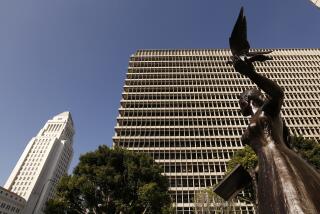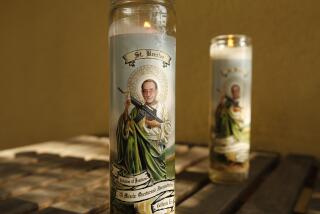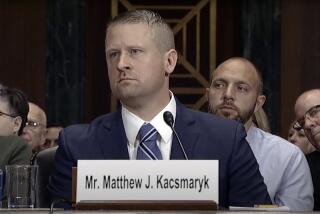Tobacco Case Judge Had Industry Ties
- Share via
Federal Judge Lewis A. Kaplan was part of the 2-1 majority that gave the tobacco industry one of its biggest legal victories in recent years--a ruling upholding dismissal of Canada’s cigarette smuggling case against R.J. Reynolds Tobacco Holdings Inc. The ruling last October by the U.S. 2nd Circuit Court of Appeals not only derailed Canada’s billion-dollar claim but also led to dismissal of similar suits against cigarette makers by the European Union and Colombia.
Internal documents disclosed in tobacco litigation show that Kaplan had represented Brown & Williamson Tobacco Corp. as a private attorney during the 1970s and ‘80s.
The documents show that as part of Kaplan’s work for Brown & Williamson, he participated in meetings of the Committee of Counsel, the inner sanctum of top tobacco lawyers that mapped the companies’ joint legal and political strategies--including how to temper government action on tobacco smuggling.
Kaplan did not disclose his former ties with the industry to lawyers for the government of Canada, though legal experts say he didn’t have to. Nonetheless, tobacco industry foes, who said the ruling was of immeasurable benefit to the entire industry, not just R.J. Reynolds, reacted with surprise and anger.
“We’re very upset about what appears to be a failure of a judge to disqualify himself in a decision as important as this,” said Gar Mahood, executive director of the Non-Smokers’ Rights Assn. of Canada, the country’s leading anti-smoking group. “I would think any reasonably intelligent layperson looking at this--quite apart from any lawyer--would say that this judge’s involvement in this decision
Larry Meyer, who attended Committee of Counsel meetings as an attorney for tobacco company Liggett Group Inc., recalled Kaplan as “a crackerjack lawyer.” Meyer told The Times that although he was “not an expert” on judicial ethics, he was “surprised that Lew [Kaplan] would not have disclosed his representation” of Brown & Williamson.
Kaplan, a U.S. District judge for the Southern District of New York, was sitting as a visiting judge with the 2nd Circuit when he cast the swing vote in the Canada case, which involved billions of contraband cigarettes that poured into Canada during the 1990s. The court ruled that the suit was barred by the “revenue rule,” a common-law doctrine that forbids the use of U.S. courts to collect taxes for a foreign government.
The judge did not return several phone calls.
However, legal experts contacted by The Times said the circumstances of the case did not require Kaplan to disclose his former ties or disqualify himself.
U.S. law states that a federal judge “shall disqualify himself in any proceeding in which his impartiality might reasonably be questioned.” But several legal experts said the restriction as interpreted in case law is not so broad as that language implies. They noted that years had passed since Kaplan’s involvement with the industry, and that his client had been Brown & Williamson, not R.J. Reynolds.
In fact, some experts said, Kaplan would have had to remove himself only if he or his former partners had defended RJR in the Canadian smuggling case.
“The critical nexus is client and subject matter that are identical to the case at hand,” said Steven Lubet, a law professor at Northwestern University school of law in Chicago. “The farther away you get from that, the less likely it is that the judge has any disqualification or disclosure obligation.”
“I think the interest in this really stems from the fact that the tobacco companies are persona non grata with a lot of people, and pretty suspect,” said Stephen McG. Bundy, a professor at the Boalt Hall school of law at UC Berkeley.
Jason Peltz, a lawyer with the Chicago firm Bartlit Beck Herman Palenchar & Scott, attorneys for Canada in the smuggling case, acknowledged that news of Kaplan’s history with the tobacco industry had taken them by surprise.
“We did not find out about it until after the decision came down,” Peltz said, adding that he is not sure what his clients would have done had they known beforehand.
But Peltz said although he believes the 2nd Circuit reached “a wrong legal conclusion ... we’re confident that that court, including Judge Kaplan, approached the case impartially and professionally.”
Moreover, Peltz said, “the case is now where it belongs, before the U.S. Supreme Court.”
However, the Supreme Court has not yet decided whether to hear Canada’s appeal of the 2nd Circuit ruling. In May, the court asked the Justice Department’s solicitor general for advice on whether to take the appeal. The solicitor general has yet to respond.
Tobacco ties are a complicating factor there too. Solicitor Gen. Theodore B. Olsen, named to the post by President Bush in February 2001, had to recuse himself because within days of his appointment he had supported RJR’s position in a friend-of-the-court brief filed with the 2nd Circuit on behalf of the National Assn. of Manufacturers and U.S. Chamber of Commerce.
Sources said principal Deputy Solicitor Gen. Paul Clement, a former partner with King and Spalding, also had to recuse himself because of the law firm’s longtime defense of Brown & Williamson in smoking and health cases. According to sources, career employees at the Office of Solicitor General have taken over the framing of a response to the Supreme Court. A Justice Department spokesman did not return phone calls.
Kaplan, 57, was appointed by President Clinton in 1994 to the U.S. District Court for the Southern District of New York. From 1970 until his appointment to the bench, he was with the New York law firm of Paul Weiss Rifkind Wharton & Garrison. The firm represented Brown & Williamson during much of the 1970s, ’80 and ‘90s. In recent years, it has also handled cases for R.J. Reynolds, though senior partner Martin London said Kaplan had left the firm by the time its involvement with Reynolds began.
Meeting agendas and minutes disclosed in tobacco litigation show that during the late 1970s Kaplan was a regular at meetings of the Committee of Counsel.
At one of the meetings in January 1978, Ernest Pepples, general counsel of Brown & Williamson, voiced concern about an article in Forbes magazine suggesting that “the cigarette manufacturers have something to do with cigarette smuggling,” minutes of the meeting said. At the time, anti-contraband bills were pending in Congress that would have increased record-keeping requirements for cigarette makers, and Pepples said he was concerned that “the bills in Congress ‘might take off.’ ”
Pepples suggested “that everyone should formulate a position so as not to appear to be favoring smuggling.”
The minutes give no indication of whether Kaplan took part in the discussion.
In December 1978, at the annual meeting of the Tobacco Institute, the industry lobby group, Chairman Horace R. Kornegay boasted that anti-smuggling legislation had been “greatly watered down,” according to a text of his remarks.
The bill as passed put the “onus on organized crime,” with “no reporting burden ... placed on the industry,” Kornegay said.
Whether cigarette smuggling is solely the work of criminal gangs, or involves complicity by major U.S. tobacco companies, is at the heart of the suits filed by Canada, the European Union and others.
More to Read
Inside the business of entertainment
The Wide Shot brings you news, analysis and insights on everything from streaming wars to production — and what it all means for the future.
You may occasionally receive promotional content from the Los Angeles Times.










